crwdns2915892:0crwdne2915892:0
You may have heard a lot about the new Fairphone 2—the small Dutch company has been making waves with its affordable, modular, conflict-free cell phone, and once again, we're one of the first to get our hands on their latest device. When we tore down the original Fairphone, we were pleased by its modularity and easy access. Today, we're excited to see what this second-generation, responsibly-designed device has in store for us. Join us as we join the movement!
Want the inside scoop on all the newest tech? Check us out on Facebook, Twitter, and Instagram to stay up-to-date with the latest news in the repair world.
crwdns2942213:0crwdne2942213:0
-
-
Here we have the second generation of the Fairphone. It's grown in size and in style:
-
5" 1080p LCD display (446 ppi) with Gorilla Glass 3 protection
-
Qualcomm Snapdragon 801
-
2 GB LPDDR3 RAM
-
32 GB internal storage with expandable storage via MicroSD slot
-
2420 mAh user-removable lithium-ion battery
-
8 MP rear camera
-
Android 5.1 Lollipop
-
-
-
Measuring in at 143 × 73 × 11 mm, the Fairphone 2 is definitely a size up from the 1st generation.
-
At 168 g (20 grams of which is the case) the Fairphone 2 is only 6 grams heavier than the 1st gen.
-
We can already spot two SIM slots underneath the see-through case. Hooray flexibility!
-
What's that? A five pin connector that seemingly connects to nothing? We'll be looking into that later...
-
This phone is lovingly labeled "Designed to open." Music to our ears!
-
-
-
The first item on our agenda is the translucent rear case. It's snug and secure, but snaps off with no tools required.
-
Where's all the adhesive? Is this a dream? Slap. No, definitely not a dream.
-
"Remove battery before releasing screen" Is this a disassembly tip on the battery?
-
Nothing makes us happier than when manufacturers include repair instructions with their device, let alone on their device.
The picture is misleading. You cannot remove the cover as a whole, it has two pieces that must come separately.
Hi Aloïs, at the time we did this teardown the back cover was one-piece. It was the first issue ever of the Fairphone 2. A teardowns is not a guide and therefore does not represent the proper way for disassembly or replacing a part. We are planning to update the actual back cover guide to the two-piece version soon. Stay tuned
-
-
-
The lack of visible screws had us a little worried, but not for long thanks to these handily-labeled clips.
-
Removing the display assembly is simply a matter of flipping the switches and sliding the panel out.
-
On the midframe we find an array of pogo pins, their counter parts are on the back of the display assembly.
-
Immediately below the contact pads on the display assembly we take off the metal shield and see where the display connects to the breakout board.
Hi
I just tried pulling out the screen and I must add that it's not that simple to do it safely...
The assembly is quite tough, you must give a good amount of strength to disassemble the screen from the board. My technique was to take in my 2 hands the body and to use a strong flat surface (a table is OK) to help me sliding the screen.
The brackets are very resisting.
At least it won't be too easy to tear it apart ^^
You are right. The display is mounted very well.
The steps and descriptions of the teardown aren't meant to be read as replacement guides.
You will find more information and pictures in the display replacement guide over here:
Fairphone 2 Display Assembly Replacement
(don't forget to unlock both sliders)
I saw a very useful tip on youtube, which comes from the Fairphone support: Give the phone a soft massage, push the display against the chassis forwards and backwards several times, only one or two milimeters, and after a short time it will move. I did that wearing latex gloves, because they have a very good friction and I didn't have to give to much pressure on the display, and in the end it was quite easy to remove.
hello,
I'm currently designing a modular laptop concept for a project at university and I'm trying to get my hands on some of the pogo / spring loaded contact connectors which they use in this.
Does anyone have any recommendations for where to find some?
Can't help with that, but must mention that that's pretty cool.
The wikipedia article on Pogo pins has links to manufacturers: https://en.wikipedia.org/wiki/Pogo_pin
I guess you find them in Huaqiangbei ( Shenzen, China)
-
-
-
Et voilà, we have the mainframe with three individually removable modules. Little icons next to each one indicate what they do:
-
Headphone jack, earpiece speaker, and front-facing camera module
-
Rear-facing camera module
-
Microphone module
-
We also discover a proud little map showing the sources of the conflict-free tin and tantalum used in the phone.
-
-
-
-
It's time to get down to
brass tacksscrews and see just how repairable the Fairphone 2 really is. -
We grab our trusty Phillips #0 screwdriver and easily remove all three modules.
-
Beneath them we find another level of spring contacts—not a flex cable or press connector in sight.
-
-
-
The modules are held together with Torx T5 screws—presumably to deter the casual user from delving too deep—but are still easy to open up.
-
We start with the top module: the front-facing camera pops right off thanks to a simple flex cable connector.
-
Spring contacts power the earpiece speaker, making for easy replacement of that as well.
-
The headphone jack, the final component, is soldered to the board. Fortunately, nothing major remains, so a replacement board should be pretty cheap.
-
-
-
Up next, the rear camera module.
-
Hopefully this unit could be upgraded in later years, à la Project Ara. Fingers crossed.
-
The camera itself is an 8 megapixel CMOS camera with a 1/3.2 inch sensor and an aperture of ƒ/2.2.
-
This module is built just like the others: a plastic case around an off-the-shelf component, connected to a pogo interface board via flex cable and connector.
-
-
-
One last module to crack open—while it's only marked with a microphone icon, there are actually quite a few components in here.
-
The vibration motor and loudspeaker are connected by spring contacts—more easily removed parts, yay!
-
The USB port and microphone are soldered to the board—not necessarily a bad thing, as a USB port requires some extra rigidity, and has significantly more pins than a speaker.
-
-
-
The time has come to delve deep into the heart of the Fairphone 2.
-
The metal shield plate, replete with useful icons, comes off first, revealing a heat spreader still hiding the exciting bits.
-
Along the way, we find an RF cable, that sends the radio signal along the side of the frame to the main antenna, and pluck it free.
What kind of tool do i use to open the 2 screws?
Those are Torx T-5
Da mein Handy baden gegangen ist, sieht man am linken, unteren Federkontkat rote Farbe, wohl ein Indikator für den Wasserschaden im Innern, kann man als “Anfänger/Nichtskönner” diesen selbst beheben, wenn man die Metallabschirmung abschraubt oder macht man dann diesen Hitzeverteiler kaputt?
-
-
-
Well isn't this a beauty? We're really digging the translucent plastic frame, showing off all of its embedded antennas and buttons—all of which connect to the motherboard by spring contacts.
-
And down on the tail there are those five pogo pins we saw earlier. This is actually a USB 2.0 device interface, with power input—ready for future expansions and fancier cases.
I've had SIM card and SD card sockets go wrong on me before so I was hoping these would be replaceable without throwing away the entire core unit. No such luck it seems. It would have been cool if these had been embedded in the frame instead. I guess that would imply a lot of spring connectors though.
Ist schon Einiges diese Bilder. Leider vermisse ich die klassische Art von iFixit mit Angabe der Schauben und der heiklen Stellen.
Grund: Ich erhielt ein FP 2 mit defektem erstem Slot. Diesen wollte ich reparieren, aber beim Anblick der geklebten gedruckten Leitungen (Antene?) von aussen habe ich es sein gelassen. War mit zu heikel, da ich nicht wusste, ob sie fest mit der Platine verbunden sind. Also habe ich diese “letzte” Platine nicht entfernt, um zu den Slots zu gelangen, die von der weissen Abdeckung geschützt sind. Hier in diesem Beitrag ist auch nichts angegeben, wie man die Platine entfernt. Ich hoffte, wenn ich an die Slots von hinten komme, dass ich die vermutlich verbogenen Kontakte mit Vorsicht wieder zurechtbiegen könnte.
I see, that's pretty clever ! Sadly, they've never made used of it :/
-
-
-
And now for the tech section.
-
Samsung KLMBG4WEBC 32 GB eMMC NAND Flash
-
Qualcomm WCN3680B Wi-Fi 802.11ac Bluetooth Combo (Based on information from the Fairphone team!)
-
STMicroelectronics LSM330DLC 6-Axis Accelerometer + Gyroscope
-
AKM Semiconductor AKM8963C 3-axis Electronic Compass
-
Texas Instruments DRV2603 Haptic Driver
-
Qorvo Antenna Switch
-
-
-
On the backside we find a lot more:
-
Samsung K3QF2F20EM-QGCF 2 GB LPDDR3 RAM, layered on top of the Qualcomm Snapdragon 801 MSM8974AB
-
Qualcomm WTR1625L RF Receiver (similar to iPhone 6)
-
RF Micro Device RF7389EU Multimode Multiband Power Amplifier Module
-
Qualcomm QFE1100 Envelope Tracking Power Management
-
Qualcomm PM8841 PMIC
-
Qualcomm WCD9320 Audio Codec
-
Qorvo RF1496A SP12T Antenna Switch
-
-
-
Fairphone 2 Repairability Score: 10 out of 10 (10 is easiest to repair)
-
The LCD and cover glass are fused, simplifying removal, but significantly increasing the cost of replacement.
-
The most commonly failing components, battery and display, can be replaced without tools.
-
Internal modules are secured with Phillips #0 screws and simple spring connectors.
-
Individual modules can be opened, and many components can be individually replaced.
-
All buttons and cables are easily accessible. Spring contacts allow for future upgrades and easy component swaps.
-
In addition to the in-phone icons and instructions, the Fairphone 2 will ship with repair documentation built-in.
I would have given this a 9/10, and 10/10 if the glass and LCD could be replaced separately, as the glass is a very common point of breakage in drops, as well as being susceptible to scratching. Knowing that replacing damaged glass will not result in the cost of an entire LCD assembly definitely gives a bit more peace of mind. A 9/10 reparability score is still very good though.
i disagree. for now a perfect 10 score is fair,.
it might warrant a drop in point in the future if a better phone comes out, but for now Repairability Score of 10 is a valid point, as it is the easiest to repair compared to other phone.
milkboy -
I disagree, the fusion of display and front glass has a good reason. By removing the air gap between the LCD and the front glass, they can reduce the Light reflections in this surfaces by a good amount.
So I wouls give this Phone a 10 out of 10.
Thoth -
Just to be fair, I believe the idea is to make the phone so robust that the glass is unlikely to get cracked in the first place. Cracked screens are absurdly common because it doesn't hurt the manufacturer to make them fragile. LCD faults are also pretty common though. If you reduce the smashed glass rate to lower than the LCD fault rate, then the risk tradeoff looks much better. And so the phone is designed so that you can drop it from 6 feet without smashing the glass, something I wouldn't suggest trying with an iPhone.
At least that's the idea. Nothing short of real-life statistics will prove it true or false.
I agree, the fused front assembly should make it a 9/10.
but they are fused by design and repairability doesn't involve that. You could maybe give it a 7/10 or 8/10 on modular design but it shouldn't affect repairability score which we're concerned with here.
By that logic even phone gets 10/10 because it's a single module and you can replace the whole thing.
From the overall design, I'm expecting this phone to be very user repairable, but also pretty unreliable.
For most users that is a pretty negative trade off.
alex -
Hi, the fusion between the LCD ans the screen is understandable but FP should offer discount the price for those who send back the broken screen units for refurbishing.
I think a 10/10 is warranted because a 9/10 would put it in the same class as many lesser phones.
But being a happy owner I'm potentially bias.
Ist es denn möglich einen einzelnen Prozessor (Schritt 14) zu tauschen und wo würde ich den bekommen?
Hanno
Da der Prozessor am Motherboard verbaut ist, würde dies einen Tausch des Boards bedeuten. Lediglich den Chip zu tauschen (auslöten und wieder einlöten) würde einen sehr großen bis technische fast unmöglichen Aufwand für einen normalen Verbraucher bedeuten. Ob die Chip-Architektur kompatibel ist mit den restlichen Komponenten ist eine ganz andere Frage.
Is it technically possible to extract the nand flash without damaging it from one Fairphone (totally dead) and to put it into another working Fairphone ? I need this in order to recover the otherwise lost pictures from the dead phone…
If yes, could you please give me some tips / advice on how to do it properly ?
Thank you in advance !
Yes this absolutely is possible! You ideally would need an reflow oven but an heatgun should work too. Look up how to reball/reflow chips for more info.
t h -
-
crwdns2947412:020crwdne2947412:0
Hi people, I am a volunteer in the Repair Café of Deventer and we are very excited about the new Fairphone2 because it showcases what we are working for: Repairable design. We are with over 300 Repair Café's in Holland now and promoting the Fairphone is one of the things I like to do. I cannot wait to receive mine, should be end of this month. So I can take it to Paris on the 12th Decmber for the big Climate March. Super glad and proud with Fiarphone, they deserve 10/10 score all the way!
Aside from making the phone thinner, fusing the display and digitizer eliminates the issue of dust infiltration (specks of crap under the glass that just can't be cleaned off) which is a warranty/service concern on devices where the two are separate. The combination is also more rigid, providing a subjectively better (firmer) "feel" when the user taps the screen. It's also, all else equal, more resilient against impact or drop damage. From an engineering standpoint, the case can easily be made that these advantages outweigh the potentially increased repair cost, especially since the fused glass is less likely to break to begin with.
need to get me one of these
Where is the GPS???
Can this be used in the US, and with which carriers?
Hey iFixit, there is a dead link in step 6 (Fairphone 2 Teardown link in the word 'map'). We changed our site so that is probably the reason. Can you fix it?
Thanks!
@Riqz: The GPS is in the Core module.
@Mgehrking: It can, but you have to research yourself where there is coverage with which carrier. Do realise we do not ship outside Europe (also not for after sales support). https://fairphone.zendesk.com/hc/en-us/a...
Esmée - Fairphone Customer Support
The dead link is now fixed. Thanks for the tip! :)
The Philips #1 Screwdriver didn't work that well, I had to use a flat 1.4mm driver to remove the screws. Maybe better to recommend using a #00?
Victor
Is there going to be a US LTE variant available anytime soon? Me want!
I'm unable to get beyond step #4 - I flipped the blue switches but I can't slide the screen out. Too bad there is no real-life Fairphone community nearer to me than London (I'm in Leamington Spa in Warwickshire). I would so much rather have a hands-on demonstration than attempt to follow a video.
Hello louisaradice, a teardown is not meant for repairs. You might want to look at the display assembly guide for that. There are also additional comments on step 4 to get the display off. Here you go: Fairphone 2 Display Assembly Replacement
I have looked at Fairphone 2 Display Assembly Replacement but I'm still none the wiser. Try as I can, I still can't slide the screen out.
Louisaradice, Have you looked at Fairphone's screen replacement video guide on YouTube? It's also possible that your clips have somehow jammed? If you are still unable to replace the display I suggest posting a question inn our Answers forum, and take photos of the clips to share with our users. Hopefully we can help you troubleshoot!
Hello,
my Mother's phone has fallen in the water. How can I diagnose which module(s) have to be replaced?
Hello Francesco,
first, make sure it is completly dry. You should have removed the battery immediately after the dive.
you can remove all three modules. Then clean the contacts with alcohol.
Then WITHOUT the modules (just screen and core) try start the phone.
If its boots up replace one module at a time then check again.
For futher help: check the fairphone forum https://forum.fairphone.com/
pa sch -
Hi, Do you know the spec of the antenna, and where I can order another one? Thanks!
Mine does also very often NOT connect to a telephone network (either 2G, 3G or 4G), all other phones I tried are much better (at the same location and with the same network provider). Would changing the antenna resolve this (I mean, how likely does such a simple part become defective)?
Ist schon Einiges diese Bilder. Leider vermisse ich die klassische Art von iFixit mit Angabe der Schauben und der heiklen Stellen.
Grund: Ich erhielt ein FP 2 mit defektem erstem Slot. Diesen wollte ich reparieren, aber beim Anblick der geklebten gedruckten Leitungen (Antene?) von aussen habe ich es sein gelassen. War mit zu heikel, da ich nicht wusste, ob sie fest mit der Platine verbunden sind. Also habe ich diese “letzte” Platine nicht entfernt, um zu den Slots zu gelangen, die von der weissen Abdeckung geschützt sind. Hier in diesem Beitrag ist auch nichts angegeben, wie man die Platine entfernt. Ich hoffte, wenn ich an die Slots von hinten komme, dass ich die vermutlich verbogenen Kontakte mit Vorsicht wieder zurechtbiegen könnte.
Im Teardown findest du solche Angaben generell nicht. Allerdings haben wir tatsächlich keinen Guide um das Motherboard zu entfernen. Hier im Bild lässt sich erkennen, dass es mit Torx Schrauben befestigt ist (ich schätze Größe T4 oder T5). Viel Erfolg
Now that the FairPhone 5 came out with a new 10/10 score, with more modularity than ever, I would be curious to know what the score of the FP2 would be if released today.













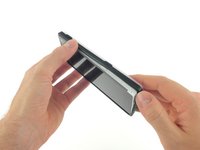
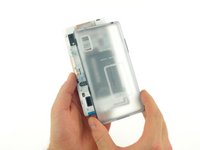
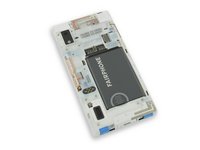


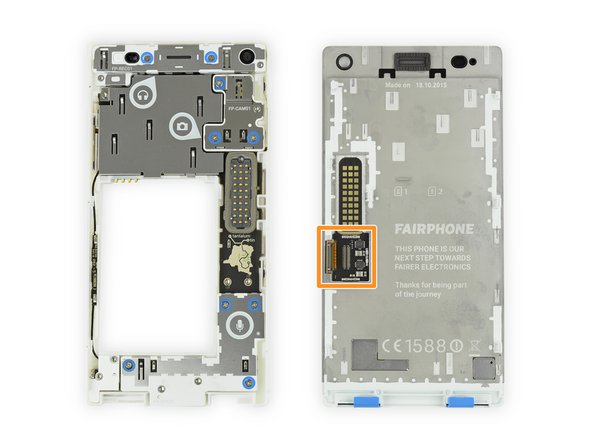
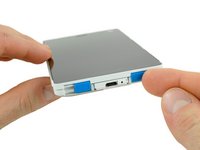
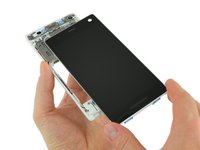
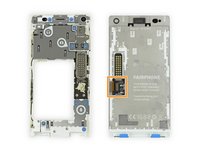


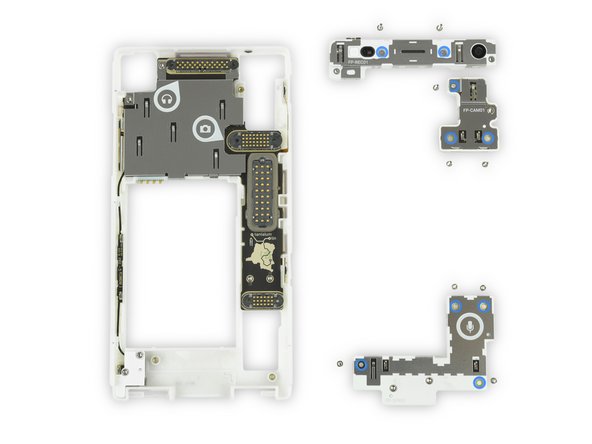
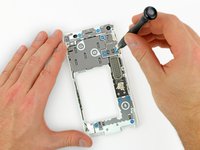
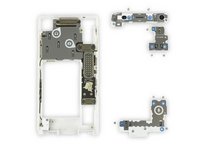

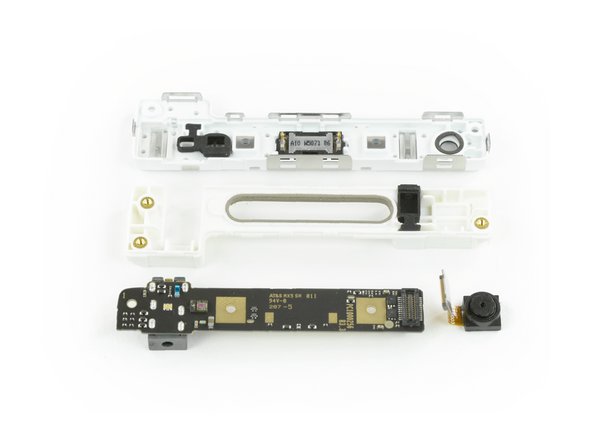
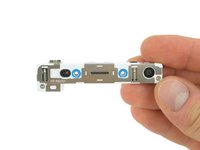
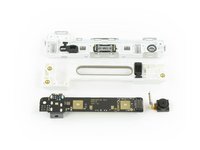

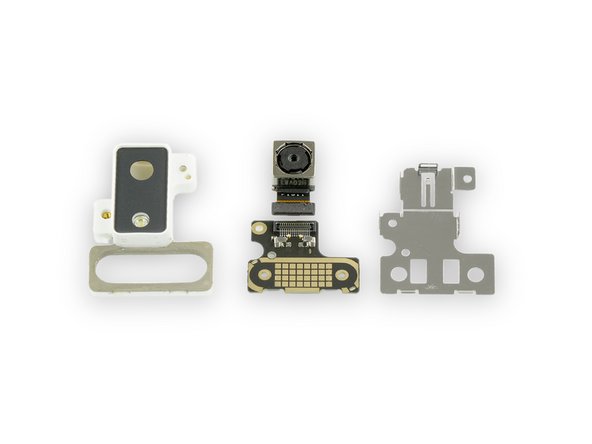

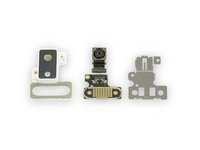

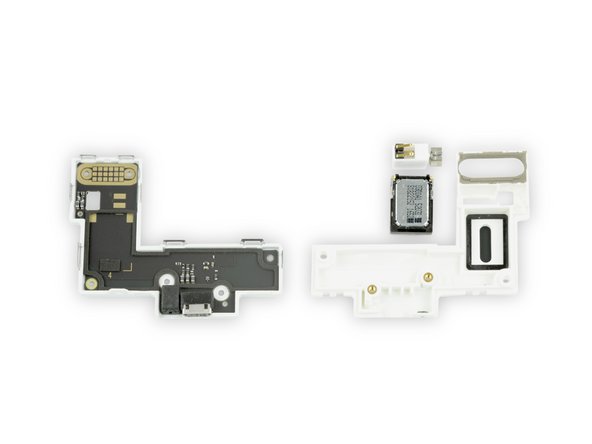
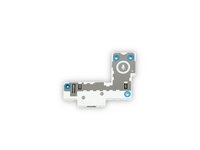
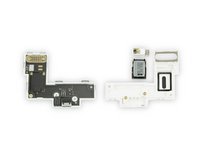

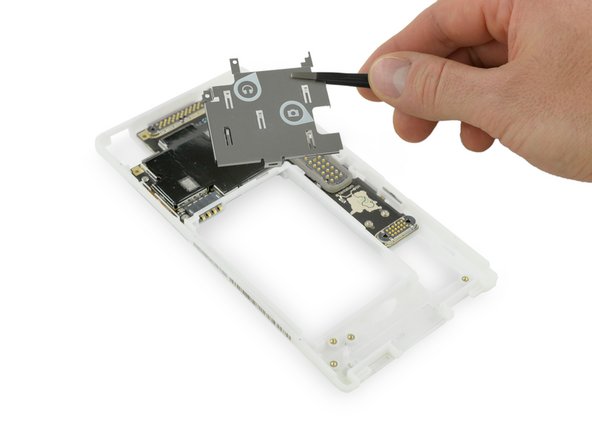



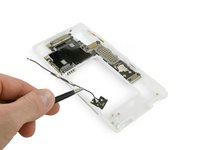





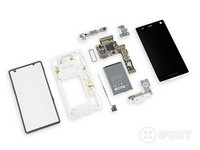



Wow! That is one ugly looking brick of a phone!
The cheap looking plastic and design would make me stay way clear of it, even if offered to take itself apart.before repairs.
I find it hard to believe that there really is a market for something like this... What's the price?
Victor Szulc - crwdns2934203:0crwdne2934203:0
I'm not too sure what makes this black rectangle any uglier than the rest available for purchase. The clear back is something of a turn-off, personally, but that's hardly a difficult thing to remedy.
Dave Davidson -
The price is 529.38€. The back cover is also available in black matte, black translucent, blue matte, blue translucent.
Julian Andres Klode -
a) Beauty is in the eye of the beholder, so you finding this phone ugly is uninteresting. b) If you prefer to continue using a 'beautiful' phone like an iPhone or Samsung, then you understand nothing about the fairphone project.
Doc Brown -
I totally love the idea and engineering behind this phone. They even noted how almost all consumers buy a rubberized case after they buy a phone, so they built that right in. That save $30 right there.
I would buy one in a second if it worked well on American phone frequencies. For all it’s modular design, they didn’t make the radio modular or global which is the only failing I can see.
The original comment optimizes what is wrong with the phone market today. There isn’t a single high end phone made today that has a removable battery (except this one) or slide out keyboard. Things I miss from my old G1. They all worry about aesthetics rather than repair-ability and battery life. Sure, it’s obvious why the phone manufacturers don’t want these devices to be easily repaired, built in obsolescence. It’s the consumers acting like sheeple parroting the manufactures promotional material that really disappoints.
Ben Zack - crwdns2934203:0crwdne2934203:0
The main problem is not the phone companies but the people who will spend $1,300.00 for the latest models. These new units do not make phone calls any better or you internet service any faster than what is available. Yes they may have a lot of fancy bells and whistles. But in the end they are just cell phones. Now I must admit I do like the camera/ video cability, but do not buy them for that. ITS A PHONE. And my old flip phone will do the job just as well as the latest Apple IPhone.
tjhoodless - crwdns2934203:0crwdne2934203:0